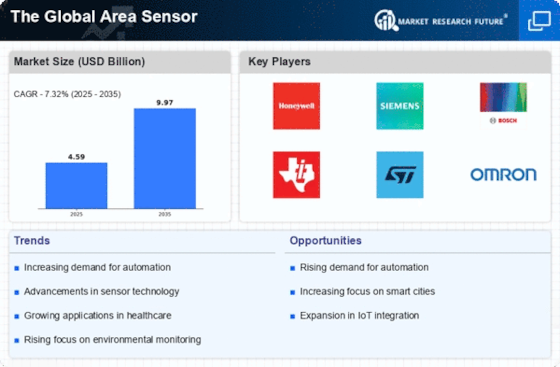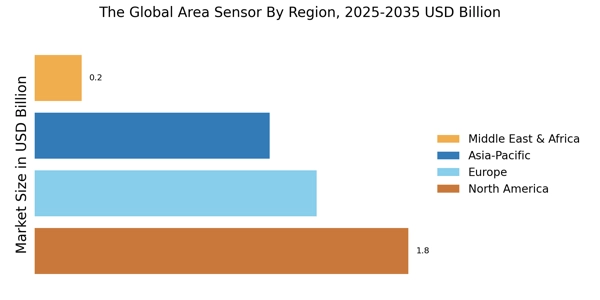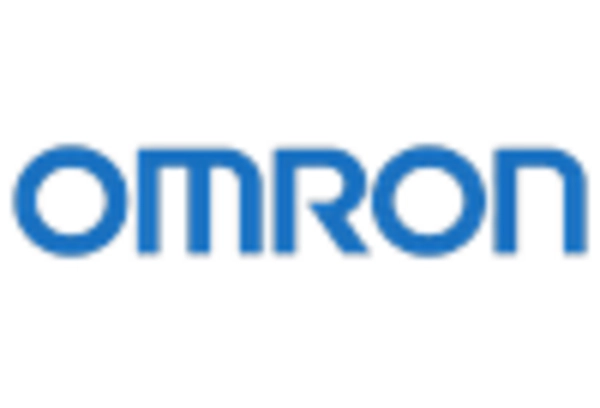Focus on Energy Efficiency
The Global Area Sensor Industry significantly. As organizations and governments implement stricter regulations aimed at reducing energy consumption, the demand for sensors that can monitor and optimize energy usage is increasing. Area sensors are essential for applications such as smart lighting, HVAC systems, and energy management solutions. In 2025, the energy management market is projected to surpass 100 billion USD, reflecting the growing importance of energy-efficient technologies. This trend suggests that area sensor manufacturers will need to innovate and develop solutions that align with sustainability goals, thereby driving growth within the Area Sensor Market.
Rising Demand for Smart Devices
The increasing proliferation of smart devices is a pivotal driver for the Area Sensor Market. As consumers and businesses alike gravitate towards automation and smart technology, the need for advanced sensors that can accurately detect and respond to environmental changes becomes paramount. In 2025, the market for smart home devices is projected to reach approximately 135 billion USD, indicating a robust growth trajectory. This surge in demand for smart devices necessitates the integration of area sensors, which are essential for functionalities such as motion detection, environmental monitoring, and security applications. Consequently, manufacturers are compelled to innovate and enhance their sensor technologies to meet the evolving needs of consumers, thereby propelling the Area Sensor Market forward.
Growth in Automotive Applications
The automotive sector is experiencing a transformative phase, with area sensors playing a crucial role in enhancing vehicle safety and functionality. The integration of area sensors in advanced driver-assistance systems (ADAS) is becoming increasingly prevalent, as these sensors facilitate features such as collision avoidance, parking assistance, and lane-keeping. In 2025, the automotive area sensor market is expected to witness a compound annual growth rate of around 12%, reflecting the industry's commitment to improving safety standards. As automotive manufacturers prioritize the incorporation of cutting-edge technologies, the Area Sensor Market is likely to benefit significantly from this trend, as the demand for reliable and efficient sensors continues to rise.
Expansion of Industrial Automation
The ongoing expansion of industrial automation is a significant driver for the Area Sensor Market. As industries strive for increased efficiency and productivity, the adoption of automated systems is becoming more widespread. Area sensors are integral to these systems, providing critical data for process control, quality assurance, and equipment monitoring. In 2025, the industrial automation market is projected to exceed 200 billion USD, underscoring the growing reliance on sensor technologies. This trend suggests that manufacturers of area sensors will need to adapt their offerings to cater to the specific requirements of various industrial applications, thereby fostering innovation and growth within the Area Sensor Market.
Emerging Applications in Healthcare
The healthcare sector is increasingly recognizing the value of area sensors, which are being integrated into various applications such as patient monitoring, diagnostics, and environmental control. The demand for remote patient monitoring solutions is on the rise, driven by the need for continuous health assessment and management. In 2025, the healthcare sensor market is anticipated to reach approximately 50 billion USD, indicating a substantial opportunity for area sensor manufacturers. This trend highlights the potential for growth within the Area Sensor Market, as healthcare providers seek to enhance patient care through innovative sensor technologies that enable real-time data collection and analysis.

















Leave a Comment